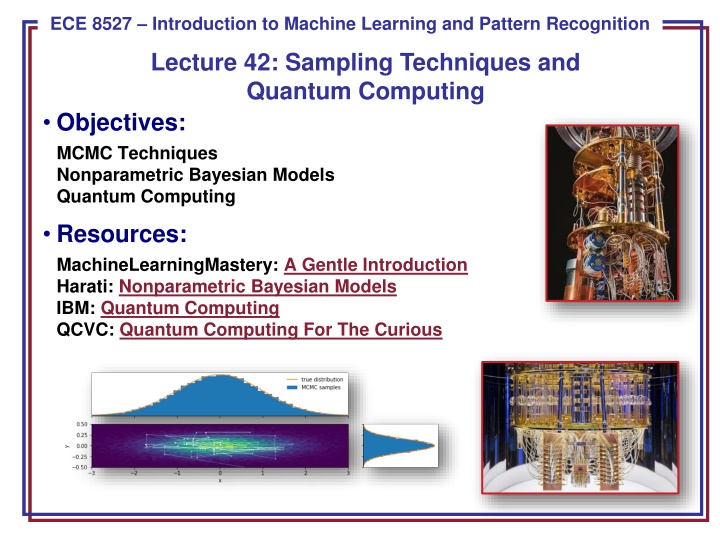
Sampling Techniques, Quantum Computing, and Machine Learning Insights
Explore the intersection of sampling techniques, quantum computing, and machine learning in this informative content. Discover the significance of Monte Carlo methods, nonparametric Bayesian models, and the impact of quantum computing on the future of ML.
Download Presentation

Please find below an Image/Link to download the presentation.
The content on the website is provided AS IS for your information and personal use only. It may not be sold, licensed, or shared on other websites without obtaining consent from the author. If you encounter any issues during the download, it is possible that the publisher has removed the file from their server.
You are allowed to download the files provided on this website for personal or commercial use, subject to the condition that they are used lawfully. All files are the property of their respective owners.
The content on the website is provided AS IS for your information and personal use only. It may not be sold, licensed, or shared on other websites without obtaining consent from the author.
E N D
Presentation Transcript
ECE 8443 Pattern Recognition ECE 8527 Introduction to Machine Learning and Pattern Recognition Lecture 42: Sampling Techniques and Quantum Computing Objectives: MCMC Techniques Nonparametric Bayesian Models Quantum Computing Quantum computing: Both here and not here Resources: MachineLearningMastery: A Gentle Introduction Harati: Nonparametric Bayesian Models IBM: Quantum Computing QCVC: Quantum Computing For The Curious
Markov Chain Monte Carlo Methods Generalization of any data-driven statistical model is a challenge. How many degrees of freedom? Solution: Infer complexity from the data (nonparametric model). Nonparametric models are very flexible the number of parameters can grow with the amount of data. Calculating a quantity from a probabilistic model is referred to more generally as probabilistic inference, or simply inference. The typical solution is to draw independent samples from the probability distribution, then repeat this process many times to approximate the desired quantity. This is referred to as Monte Carlo sampling or Monte Carlo integration, named for the city in Monaco that has many casinos. The solution to sampling probability distributions in high-dimensions is to use Markov Chain Monte Carlo, or MCMC for short. ECE 8527: Lecture 42, Slide 1
Quantum Computing Quantum computing is an area of computer science that uses the principles of quantum theory. Quantum theory explains the behavior of energy and material on the atomic and subatomic levels. Quantum computing uses subatomic particles, such as electrons or photons. Quantum bits, or qubits, allow these particles to exist in more than one state (i.e., 1 and 0) at the same time. Theoretically, linked qubits can exploit the interference between their wave- like quantum states to perform calculations that might otherwise take millions of years. Classical computers today employ a stream of electrical impulses (1 and 0) in a binary manner to encode information in bits. This restricts their processing ability, compared to quantum computing. ECE 8527: Lecture 42, Slide 2
Summary Sampling techniques, once popular in machine learning, are being revisited due to their relevance to quantum computing. Quantum computers solve certain constrained optimization problems very efficiently. It remains to be seen how quantum computing will impact machine learning. Current hardware is incapable of handling complex ML systems, so researchers are exploring hybrid approaches. ECE 8527: Lecture 42, Slide 3











